Introduction
Abaqus provides the following models to predict progressive damage and failure:
• Progressive damage and failure for ductile metals
• Progressive damage and failure for fiber-reinforced materials
• Progressive damage and failure for ductile materials in low-cycle fatigue analysis
In addition, Abaqus offers:
• a concrete damaged model
• specialized capabilities for modelling damage and failure in cohesive elements.
General framework for modelling damage and failure
In Abaqus the specification of a failure mechanism consists of four distinct parts:
• the definition of the effective (or undamaged) material response a-c
• a damage initiation criterion c,
• a damage evolution law c-d
• a choice of element deletion whereby elements can be removed from the calculations once the material stiffness is fully degraded d
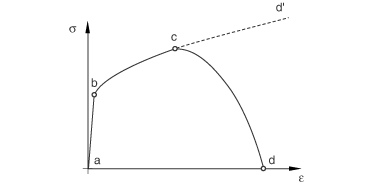
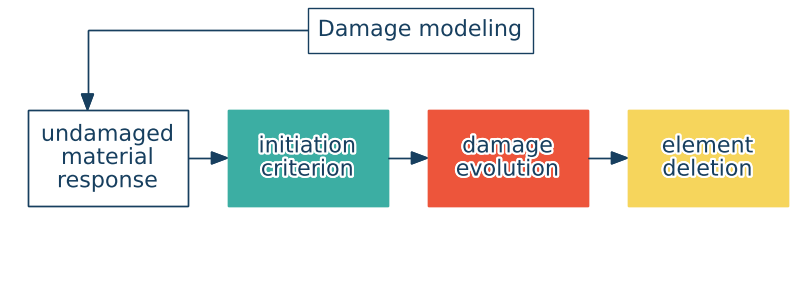
Ductile metals
Damage initiation
Two main mechanisms can cause the fracture of a ductile metal: ductile fracture due to the nucleation, growth, and coalescence of voids; and shear fracture due to shear band localization. Based on phenomenological observations, these two mechanisms call for different forms of the criteria for the onset of damage.
The model assumes that the equivalent plastic strain at the onset of damage, $\bar{\varepsilon}_D^{pl}$, is a function of stress triaxiality and strain rate:
$$\bar{\varepsilon}_D^{pl}(\eta, \dot{\bar{\varepsilon}}^{pl})$$The stress triaxiality ($\eta$) is a dimensionless parameter used to describe the ratio of hydrostatic stress to the equivalent von Mises stress. It plays a critical role in ductile fracture, damage modeling, and failure prediction.
Assuming that the Cuachy stress tensor is define as
$$\boldsymbol{\sigma} = \begin{bmatrix} \sigma_{11} & \sigma_{12} & \sigma_{13} \\ \sigma_{12} & \sigma_{22} & \sigma_{23} \\ \sigma_{13} & \sigma_{23} & \sigma_{33} \end{bmatrix}$$
The stress triaxiality parameter is compute as
$$\quad \eta = -p/q,$$where
$$p = -\cfrac13\left( \sigma_{11}+ \sigma_{22} + \sigma_{33} \right)$$and
$$q = \sqrt{\frac{1}{2} \left[ (\sigma_{11} - \sigma_{22})^2 + (\sigma_{22} - \sigma_{33})^2 + (\sigma_{33} - \sigma_{11})^2 + 6(\sigma_{12}^2 + \sigma_{23}^2 + \sigma_{13}^2) \right]}$$
The criterion for damage initiation is met when the following condition is satisfied:
$$\omega_D = \int \cfrac{d \bar{\varepsilon}^{pl}}{\bar{\varepsilon}_D^{pl}} = 1$$In Abaqus the ductile criterion can be used in conjunction with the following plasticity models
• Mises,
• Johnson-Cook,
• Hill,
• Drucker-Prager
Damage evolution
In the context of an elastic-plastic material with isotropic hardening, the damage manifests itself in two forms:
• softening of the yield stress and
• degradation of the elasticity.
The solid curve in the figure represents the damaged stress-strain response, while the dashed curve is the response in the absence of damage. The damaged response depends on the element dimensions such that mesh dependency of the results is minimized.

Defining damage evolution based on effective plastic displacement
Once the damage initiation criterion has been reached, the effective plastic displacement, $\dot{\bar{u}}^{pl}$, is defined with the evolution equation
$$\dot{\bar{u}}^{pl} = L \dot{\bar{\varepsilon}}^{pl}$$where $L$ is the characteristic length of the element.
The evolution of the damage variable with the relative plastic displacement can be specified in tabular, linear, or exponential form.

Defining damage evolution based on energy dissipated during the damage process
The fracture energy per unit area, $G_f$ , to be dissipated during the damage process directly can be specified to modeled damage evolution.
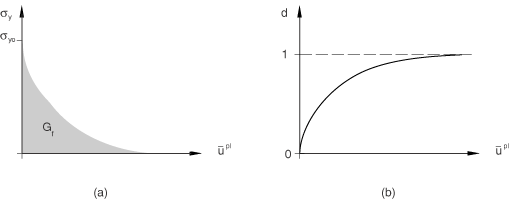
Removing the element from the mesh
Elements are deleted by default upon reaching maximum degradation. Abaqus applies damage to all stiffness components equally for elements that may eventually be removed:
$$\ss = (1-D)\bar{\ss}$$In addition to the standard output identifiers available in Abaqus, the following variables have special meaning when damage evolution is specified:
STATUS - Status of element (the status of an element is 1.0 if the element is active, 0.0 if the element is not).
SDEG Overall scalar stiffness degradation, $D$.
Unsymmetric equation solver
In general, if any of the ductile evolution models is used, the material Jacobian matrix will be nonsymmetric. To improve convergence, it is recommended that the unsymmetric equation solver is used in this case.
Porous metal plasticity
The porous metal plasticity model is used to model materials with a dilute concentration of voids in which the relative density is greater than 0.9.
Yield condition
The relative density of a material, $r$, is defined as the ratio of the volume of solid material to the total volume of the material. The relationships defining the model are expressed in terms of the void volume fraction, $f$, which is defined as the ratio of the volume of voids to the total volume of the material. It follows that
$$f = 1 -r$$In 1977 Gurson proposed a yield condition as a function of the void volume fraction. This yield condition was later modified by Tvergaard (1981) to the form
$$\phi = \left(\cfrac{q}{\sigma_y}\right)^2 + 2q_1 f \cosh \left( -q_2 \cfrac{3p}{2\sigma_y}\right) - (1+q_3 f^2) = 0$$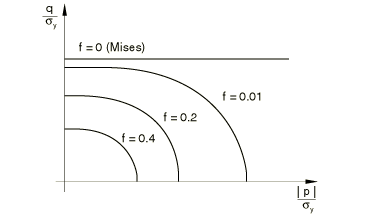
Void growth and nucleation
The total change in void volume fraction is given as
$$\dot{f} = \dot{f}_{gr} + \dot{f}_{nucl}$$where $\dot{f}_{gr}$ is change due to growth of existing voids and $\dot{f}_{nucl}$ is change due to nucleation of new voids.
Concrete damaged plasticity
The concrete damaged plasticity model in Abaqus provides a general capability for modeling concrete and other quasi-brittle materials.
The model is a continuum, plasticity-based, damage model for concrete. It assumes that the main two failure mechanisms are tensile cracking and compressive crushing of the concrete material.
Uniaxial tension and compression stress behavior
The model assumes that the uniaxial tensile and compressive response of concrete is characterized by damaged plasticity.
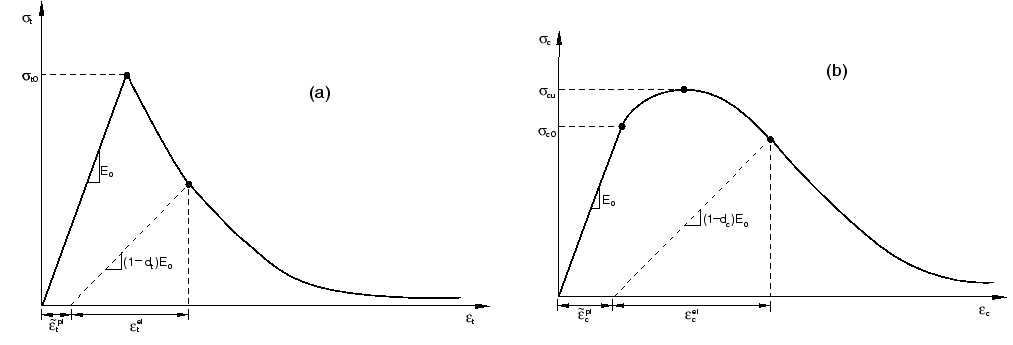
Yield condition
The model makes use of the yield function of Lubliner et. al. (1989), with the modifications proposed by Lee and Fenves (1998) to account for different evolution of strength under tension and compression.
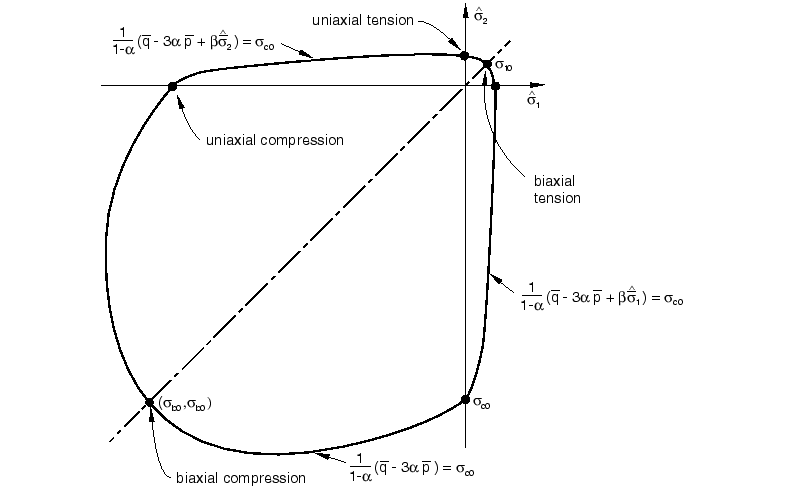
Example
Ductile damage of thin steel sheet.
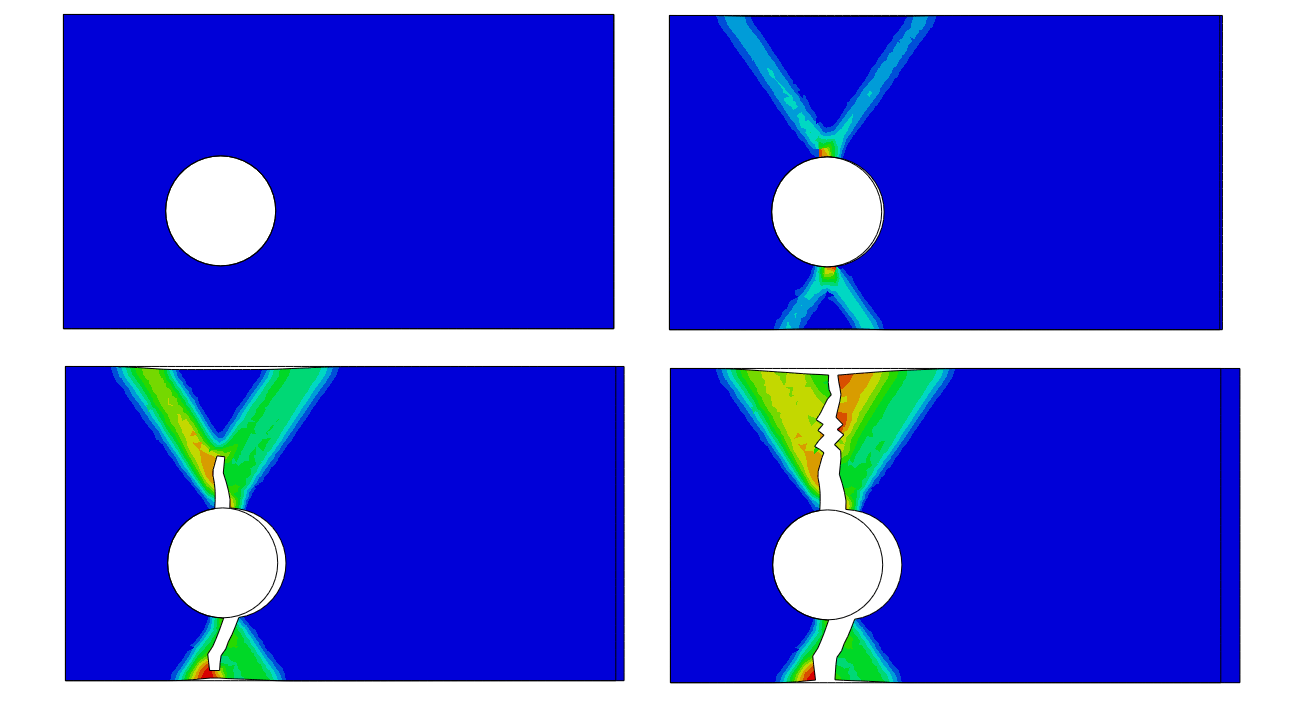
The developed example script can be downloaded at: